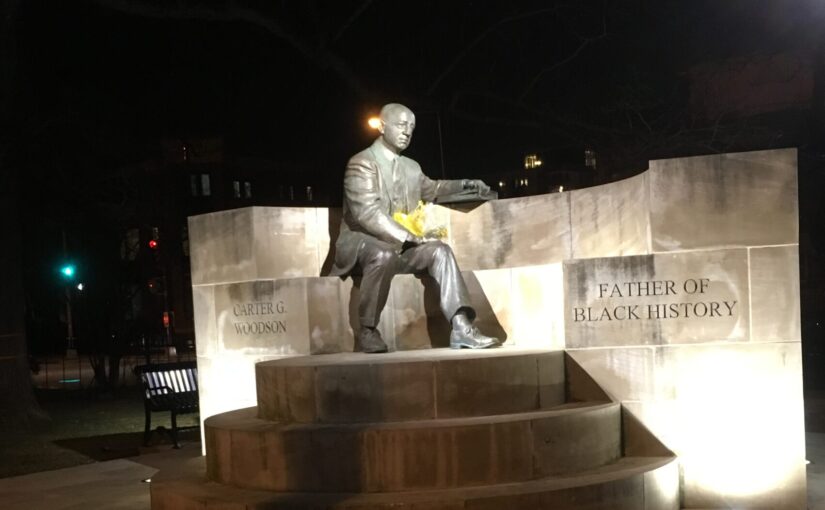Carter G. Woodson, a Shaw resident, living and working on the 1500 block of 9th St NW, created Negro History Week. This later became Black History Month. Last year I reviewed Carter G. Woodson’s Mis-Education of the Negro. I thought I would review his other book The History of the Negro Church this year.
I’ve read the first chapter. I want to find who edited this thing and do bad things to their grave. If Dr. Woodson edited it, then, this is evidence that authors should get someone else to edit their work.
I’m going to start with something from the book’s preface:
Whether or not the author has done this task well is a question which the public must decide. This work does not represent what he desired to make it. Many facts of the past could not be obtained for the reason that several denominations have failed to keep records and facts known to persons now active in the church could not be collected because of indifference or the failure to understand the motives of the author. Not a few church officers and ministers, however, gladly cooperated with the author in giving and seeking information concerning their denominations.
Given the current lack of popularity, compared to Mis-Education, I will say he had not done his work well. It is a hard read.
My summation of chapter one is that Blacks were a second thought to European missionaries. When they did get around to bringing Christianity to those of African descent into the New World there was a resistance because of an unwritten law (no citations) that once slaves became Christian, they would need to be freed. Catholics didn’t try hard enough and Protestants were more successful at evangelization to Blacks in America.
The one thing I learned reading this chapter was that Quakers taught African American slaves to read in Virginia and North Carolina.
I just wish there were citations for this piece of information and that gets to my first pet peeve. This book is 100 years old and historians of this period have a bad habit of not providing citations to back up anything they wrote. In the copy I have, I do not see end notes, nor is there a bibliography at the end. I blame the time period.
The other pet peeve I’ve revealed early on, was the need for an editor. This was not written for a general audience. It has the charm of a graduate dissertation. He uses $4 words when a $.25 word would do. He’s overly wordy as if he’s getting paid, per word, like a Raymond Chandler novel. The deep need for an editor, someone to strike out some sentences and suggest a better way of making a point, just annoyed the heck out of me.
I just discovered there is an audio book of The History of the Negro Church from December 2020. I will try to listen to this and maybe I’ll do more than 2 chapters this month.


I like finding expressions in other languages.
“To have your cake at eat it too” translates to something in french like you can’t have a fat wife and a full glass of wine.
We have the expression “the coast is clear” but from the spanish it it “Moors on the coast” which means that since the police are on the coast stopping slave raids you can get away with anything. Reminder that slavery worked both ways.
http://www.word-detective.com/2011/12/coast-is-clear/
So yes slavery has a complex history in Spain. There definitely were laws about enslaved muslims who could free themselves by converting to Catholicism. Likewise a death penalty for Muslim to convert on the other side. I am fairly certain you could free yourself legally in the ottoman world by becoming a muslim. You also didn’t have to pay taxes!
As you said, little evidence that played a role in turning slaves into catholics or not. There is an interesting side story on how unfavored spanish-black or indian-black unions were in latin america. Far more interesting is how much African DNA survived in populations with no visible black residents –Argentina is the best example. This is different than the US where little intermixture on the white side but large scale on the African side.
The history of conversion and slavery is probably a PH.D thesis on its own – and probably is — and as you said 100 years ago people were not as addicted to footnotes and endnotes as they are today. So I’d say there was something there, and it is a largely throwaway line. Clearly in spanish speaking populations with a large african component there is a tremendous catholics today.
I would kill for some footnotes or endnotes or even a sweet little bibliography at the end.
But alas, they don’t show up in Mis-Education of the Negro nor the History of the Negro Church.
I must give Woodson credit for doing what he did. He deserves the accolades, because he did get this Negro History Week thing going. Being 100 years in the future and having the background I have, I see (and it irritates me) the weaknesses in his work, but I have tools and privileges Woodson couldn’t even dream of, so there’s that.